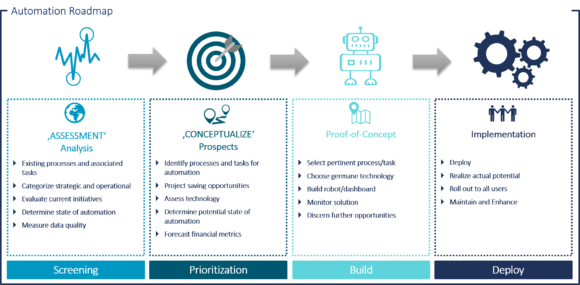Digital transformation of procurement is not a question of necessity but of when and how to start. In this article we explain how to automate procurement and drive its transformation journey.
On the one hand, the world is at the brink of a technology revolution, and on the other hand, procurement is increasingly bringing more value to supply chains. The relevance of the integration of digital technologies and the procurement function is of vital importance to the value chain now more than ever. Automation technologies are set to spearhead the race for digital transformation as they are simpler and faster to implement and to integrate with big data environments. In this context, our take on why to automate procurement? and how to overcome automation hurdles? naturally leads to the question ‘how to automate procurement?’
What do we know?
From our academic research study on understanding the repercussions of automation technologies on the procurement function, we know that early adopters of digital transformations have the biggest competitive advantage, yet a general prevailing outlook on the current state of automation lacks focus and is happening at a crippling pace. The study also reveals that digital transformations led by automation technologies will be a top priority for businesses and is expected to be the cornerstone for driving innovation.
Based on our recent customer projects, we see two major cornerstones under the umbrella of procurement transformation – an organizational as well as a technological impact, both heavily influencing the way procurement will operate in the future.
From an organization point of view, it can be expected that a shift from a 20-80 organizational model of the strategic-operational workforce to an 80-20 model is very likely to happen. Procurement practitioners having traditional negotiating and contracting skills along with technical skills will drive procurement into the future.
Also, there is a significant gap between the current state of automation and the expected state of automation in the procurement function, with estimates as high as 75% while change management is the biggest enabler for future automation in procurement. Tasks and processes inherently operational in nature have a significantly higher potential to be automated. Technologies such as RPA and data-driven technologies are set to have the biggest impact in the next 2-5 years, AI in 5-10 years and blockchain in 10+ years.
So, how can we prepare for such a transformation? Here is the answer.
Now, what to do?
CAMELOT experts have conceptualized a roadmap to automate the procurement process based on their experience with customers undergoing various transformational journeys and considering the impact of digital technologies on the procurement function. The process involves a comprehensive as-is analysis of existing processes and associated tasks to identify scope for re-engineering and eliminating manual intervention. This is followed by categorization of the inherent nature of procurement tasks and processes, a critical aspect of determining automation potential, followed by an evaluation of the current state of automation and data quality.
The next steps involve assessing the potential for automation, choosing the relevant technologies and building a chronological automation sequence for the identified tasks and processes. This stage also forecasts all the relevant financial metrics involved to understand all appropriate constraints. Subsequent phases include developing PoCs for monitoring purpose and exploring further saving opportunities. In this phase, all constraints and dependencies will be identified, categorized and addressed. The final phase will be rolling out the solution for all users whilst surveilling for enhancement opportunities.
A structured assessment is fundamental to undergo a transformational journey over the next years. While technology is constantly developing, having a structured and strategic starting point with a clear vision of what to achieve over the next years is critical to successful transformations.
It is not a question of necessity for procurement organization to transform, but rather the question of where, when and how to start the transformation, and not lose the traction in the process.


